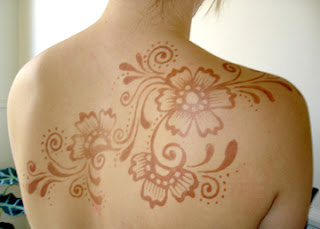 |
| source |
Hi Gorgeous!
I know I mentioned in this past Tuesdays Are For Tresses post about how I plan on getting a henna tattoo. Not to be confused with the regular tattoo which I do intend on getting this year. Henna tattoos are temporary, normally not lasting past a couple of weeks. I ended up having a brief convo with Zainab1 (AuNaturale blogspot) about henna tattoos that sparked my interest beyond my cosmetic desire for one.
So allow me to take you on a pictoral/informative journey on henna tattoos:
Henna is also known as, or goes by the name of, "mendhi".
 |
| source |
Before the recorded introduction of henna; Hindu, Buddhist, and other Indian women used dyes from the fruits of Laksa trees to stain the palms of their hands and soles of their feet. According to Guatama Vajracharya, professor of art history at the University of Winsconsin in Madison, women wore these tattoos decoratively every day. “Widows, as a sign of mourning, did not wear them,” Vajracharya said.
 |
| source |
 |
| source |
 |
Henna / Mehndi has a very long history with centuries of migration and cultural interaction. Many different traditions began in multiple different cultures over the past 5000 years and it has now become part of our modern history as well. Henna / Mehndi has a rich and beautiful past including evidence that it was originally used in ancient Egypt to stain the fingers and toes of the Pharaohs prior to mummification. The most common association with henna tattooing is its use within the Indian culture used as a ceremonial art form for wedding ceremonies. Along with it's beautiful and eye catching cosmetic uses, henna / mehndi is also known for its natural healing properties for health problems such as headaches, liver disorders, skin diseases and more.
 |
| source |
 |
| source |
The art form of henna/mehndi differs from region to region, as it is a tradition that has been a part of so many cultures over the past 5000 years to present. Arabic designs tend to be more floral in their patterns while Indian designs are made of a delicate blending of fine lines creating striking pattern which covers a larger area of the skin such as the hands and feet. You will see this Indian tradition most often used as part of a wedding ceremony. Africans and Native/South American Indians have used henna tattooing as well but their designs tend to be larger geometric designs as opposed to the more often seen delicate designs of India. The modern henna tattooing that has now become part of many cultures worldwide which didn't originally use this form of body art can be quite diverse. Some people choose to wear a traditional Indian design while others use henna tattooing as a replacement for a modern tattoo design. Henna tattoos have become a very popular way to express ones individuality without the pain and permanency of an actual tattoo.
 |
| source |
 |
| source |
During the 16th century, henna’s popularity expanded through Pakistan and North India by the Moguls. Females used henna to decorate their bodies for ceremonies, especially weddings.
 |
| source |
 source |
| I just love this henna design on the pregnant belly. There's something so endearing about it. |
 |
| source |
Resources: http://www.essortment.com/ and http://www.henna-tattoos-kits.com/.
Wishing you a wonderful weekend!
Post Title → MY HENNA DREAMS ARE FILLED WITH.....